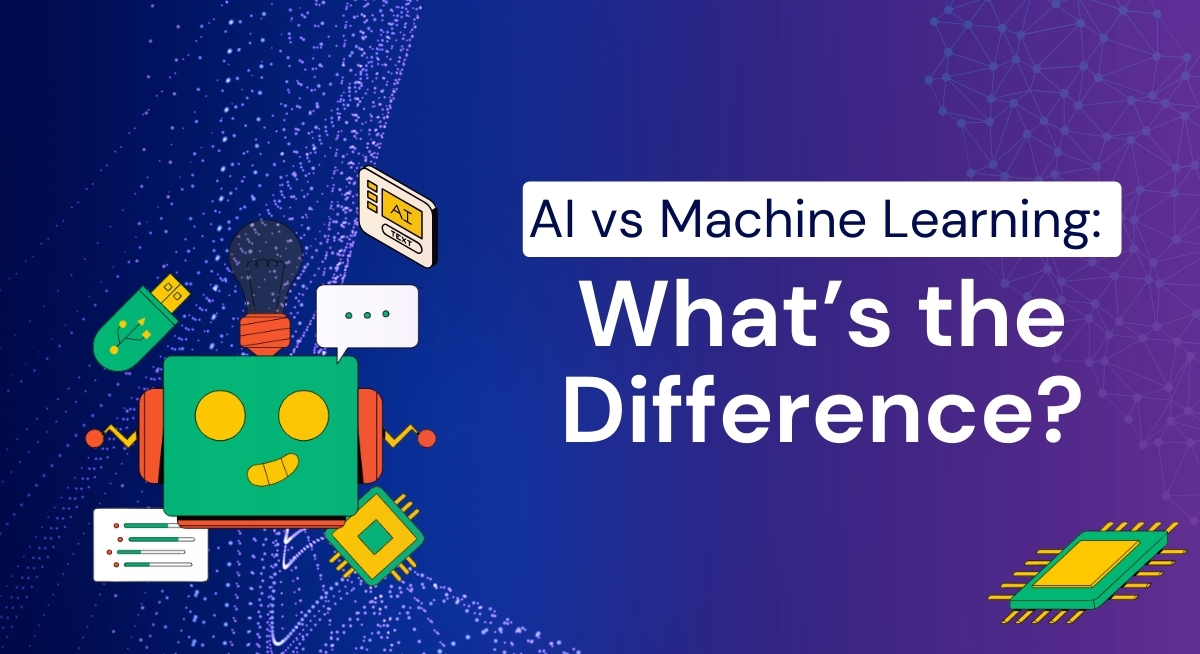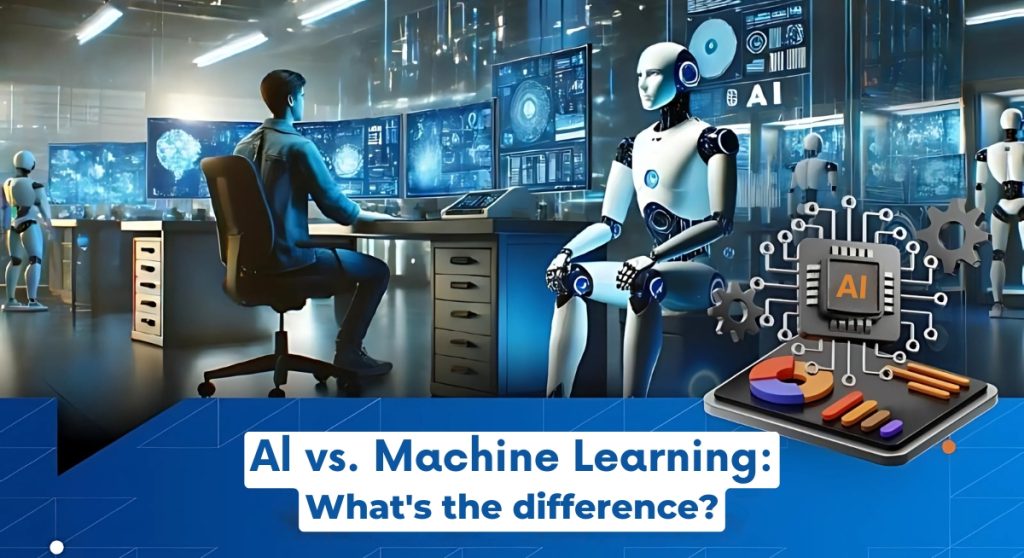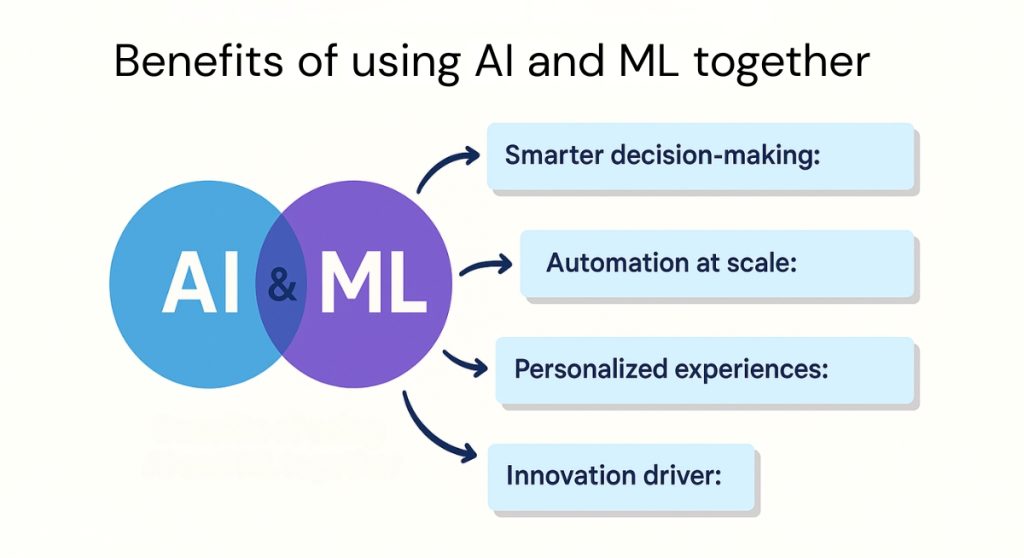
If you’ve ever scrolled through tech blogs, startup pitches, or LinkedIn posts, chances are you’ve seen “AI” (Artificial Intelligence) and “Machine Learning (ML)” used almost interchangeably. But are they really the same thing? Not exactly. While they’re closely related, there’s a subtle but crucial difference that everyone—from students to business leaders—should understand.
While they’re closely related, there’s a subtle but crucial difference that everyone—from students to business leaders—should understand. At Gignaati, a trusted AI learning platform in India, we often meet learners and professionals who confuse the two. In this blog, we’ll break it down simply, compare AI vs Machine Learning, highlight real-world use cases, career opportunities, and even touch upon the rise of Generative AI vs ML in today’s fast-changing tech landscape.
Artificial Intelligence (AI) is the broad concept of creating machines that can think, reason, and act like humans. At its core, AI is about simulating human intelligence in systems so they can solve problems, make decisions, and adapt to different situations.
Think of AI as the umbrella term under which multiple technologies sit. AI doesn’t just rely on data; it can also work through rule-based systems, expert systems, natural language processing, robotics, and computer vision.
Examples of AI in daily life:
For a deeper dive, check out our blog for the Beginner’s Guide to Artificial Intelligence.
While AI is the brain, Machine Learning (ML) is like one of its special skills. Machine Learning is a subset of AI that allows machines to learn from data and improve automatically without being explicitly programmed.
Instead of being told step-by-step what to do, ML systems analyze patterns in data and use those patterns to make predictions or decisions.
Everyday ML examples:
In simple terms, AI is the overarching concept, and ML is one approach to achieving it.
Here’s where most people get confused. Let’s simplify the AI vs Machine Learning difference:
| Aspects | AI | ML |
|---|---|---|
| Scope | AI is the overall concept of machines acting smart | ML is a subset focused on data-driven learning |
| Approach | AI can be rule-based or data-driven | ML is always data-driven |
| Goal | AI’s goal is to simulate human-like intelligence. | ML’s goal is to find patterns in data and improve performance. |
| Examples | AI includes robotics, natural language processing, and expert systems. | ML examples include recommendation engines, spam detection, and predictive analytics. |

Many learners search for Generative AI vs ML because Generative AI (like ChatGPT) is a direct application of ML but with creative outputs. This makes it an exciting career path within AI.
So why does this even matter?
And here’s where data tells the story:
These numbers make it clear: understanding the difference between AI and ML isn’t just academic—it’s critical for businesses making investment and technology decisions.

When combined, AI and ML don’t just coexist; they supercharge each other.
For businesses, leveraging AI and ML together translates into cost savings, higher efficiency, and a competitive advantage.
Let’s put this into perspective with real examples:
For professionals who want to get hands-on with these technologies, taking the time to learn AI and Machine Learning through structured programs can be a game-changer for career growth.
At the end of the day, the difference between AI and Machine Learning is simple: AI is the broader vision of machines acting smart, while ML is one of the key methods that make that vision real.
If you’re in business, tech, or just curious about the future, knowing this difference helps you separate hype from reality. And as Generative AI, Responsible AI, and MLOps continue to evolve, understanding the foundations of AI and ML will be more important than ever.
Want to future-proof your skills? Enroll in specialized AI training courses with Gignaati, a trusted platform offering hands-on expertise to help you stay competitive in the fast-evolving world of technology.
No, Machine Learning is not the same as Artificial Intelligence. AI is the broader field focused on building machines that can mimic human intelligence, perform reasoning, and make smart decisions. Machine Learning (ML) is a subset of AI that enables systems to learn from data and improve over time without being explicitly programmed. In short, AI is the overall concept of intelligence in machines, while ML is one of the main techniques used to bring that intelligence to life.
Yes, AI can exist without Machine Learning. While most modern AI relies heavily on ML, earlier AI systems were built using rule-based logic, expert systems, and symbolic AI that didn’t involve learning from data. For example, early chess engines and diagnostic systems followed predefined rules to make decisions. These systems were intelligent in limited ways but could not learn or adapt. Today, ML powers most breakthroughs in AI, but it’s important to remember that AI is a broader concept than ML.
Many real-world examples highlight the difference between AI and ML. AI examples include self-driving cars, robotics, chatbots, and smart assistants like Alexa that can simulate human intelligence. Machine Learning examples include email spam filters, recommendation engines on Netflix, fraud detection in banking, and predictive text on smartphones. The key difference is that AI can include both rule-based and learning-based approaches, while ML specifically focuses on data-driven learning systems that get better with more data.
Deep Learning (DL) is a subset of Machine Learning that uses complex structures called neural networks to mimic the way the human brain processes information. While ML focuses on algorithms that learn from data, DL takes it a step further by handling large volumes of unstructured data such as images, videos, and natural language. This is why Deep Learning powers applications like image recognition, facial recognition, voice assistants, and advanced natural language processing models like ChatGPT. So, the hierarchy is: AI > ML > Deep Learning.
Understanding the difference between AI and ML is important for both professionals and businesses. Many marketing pitches use “AI-powered” loosely, but knowing the distinction helps you see through hype. It also helps organizations decide whether they need a broad AI solution or a specific ML model to solve problems like fraud detection or personalization. For learners and job-seekers, this clarity guides career paths in AI, ML, or Deep Learning. In short, knowing the difference builds credibility and helps in making smarter technology decisions.
Explore Gignaati.com – where top AI innovators showcase verified AI agents for real-world solutions.
© 2025 Gignaati is a product of Smartians.ai. All rights reserved.